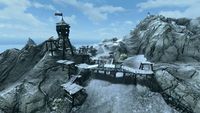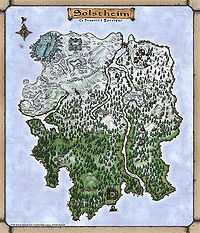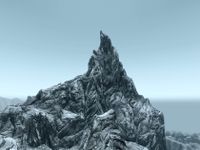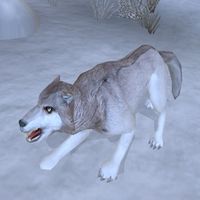Lore:Moesring Mountains
| This page is currently being redesigned for the Lore Places Project (LPP). The page may need work to meet the standards outlined on the project page. |
| To meet our site's higher standard of quality, this article or section may require cleanup. The user who placed this here had the following concern: Needs more fact-checking/description - the tallest peaks, the passes, Fourth Era transitions, general corrections To leave a message about the cleanup for this article, please add it to this article's talk page. |
| Moesring Mountains | |
|---|---|
| Type | Mountain Range |
| Continent | Tamriel |
| Province | Morrowind |
| Region | Solstheim |
| Appears in | Bloodmoon, Dragonborn |
The Moesring Mountains region of northwestern Solstheim is a barren frozen wasteland mostly composed of the eponymous mountain range. The northern and western borders are white coastlines along the Sea of Ghosts, while to the south are the Isinfier Plains. To the east, the Harstrad River traditionally separated the Moesring from the northern reaches of the Felsaad Coast.[1] In the Fourth Era, the delta of the Harstrad shifted northwest, one of several transformations likely wrought by the Red Year.[2]
Geography[edit]
The Moesring Mountains rise steeply along their south and east perimeter, turning all of northwestern Solstheim into a natural fortress. Treacherous mountain climbing can be avoided thanks to several mountain passes, which help create something of a road system connecting the Moesring with the rest of Solstheim. However, a number of threats may arise along these narrow passes, including Riekling barricades and encampments.[1][2] Ancient Nordic and Dwemer ruins dot the range.[2] Castle Karstaag was a mysterious ice fortress which dominated the northern reaches of the mountains. In the late Third Era, some locals doubted it even existed. Those who knew better understood the castle was home to the frost giant Karstaag,[3] who ruled over his Riekling servants and many grahl from an enormous ice throne.[4]
Despite the unforgiving climate, mining opportunities draw some to the Moesring. The region is rich in sapphire deposits, hosts some ebony and orichalcum ore veins, and the Fourth Era would see the emergence of heart stone mines even in the northwest of the island (although deep mines tend to become home to Rieklings).[2] The rare magical ice stalhrim can still be plundered from Nordic barrows, if one has the tools.[1][2]
One mountain pass begins southwest of Hvitkald Peak, which anchors the southern end of the range.[nb 1][5] A northern pass traverses the northern slopes of the range.[1] In the middle of the range, west of the Wind Stone obelisk held sacred by the Skaal, is Moesring Pass.[2] This leads to Hrothmund's Bane, a massive wolf petroform presumably constructed by the residents of Thirsk in honor of their first chieftain, Hrothmund the Red.[1][2][6]
History[edit]
In the distant past, the Moesring Mountains were home to many, including Snow Elves and frost giants. It was in the white plains and slopes of this region where the Battle of the Moesring took place, where the Nords claimed victory over the Snow Elves,[7] and claimed the island for themselves.[8] The Dwemer of Solstheim, who built the stronghold of Fahlbtharz north of Hvitkald Peak, presumably also disappeared circa 1E 700 like the rest of their race,[9] leaving Nords to dominate the island for thousands of years. They built barrows and temples of the Dragon Priests, but if the Nords formed any towns in the barren mountains, none have survived. Scattered mountain folk long made their homes in the Moesring,[6] such as Fryse Hags, witches dedicated to the Nordic goddess Kyne, who could be found in secluded ice caves into the late Third Era.[1][10] However, if any remain, they are elusive; the only continuous inhabitants in modernity one is likely to find are the Rieklings.[2]
The Skaal tribe, which resides across the river east of the mountains, held an uneasy truce with the frost giant Karstaag for many years.[11] They heard nothing of him for some time before he was killed in 3E 327,[12] leaving Rieklings to occupy the castle.[1][2]
The massive Mortrag Glacier had encompassed the northwestern tip of Solstheim since time immemorial.[1] However, in 3E 427, following the fulfillment of what the Skaal called the Bloodmoon Prophecy, the glacier collapsed into a jagged ice field.[13] The Fourth Era, which brought the cataclysms of the Red Year of 4E 5,[14] would see the range literally reshaped.[2]
Hvitkald Peak, once the tallest mountain on the island, became only one of several very tall peaks in the range, including Mortrag Peak, Frykte Peak, and Mount Moesring. The once-massive Mortrag ice field diminished into a series of jagged icebergs off of Solstheim's now-exposed northwestern shoreline. The Harstrad River no longer joined with the Isild River; instead the two reached separate deltas in the northern bay. The Harstrad's headwaters also shifted and became inhabited by spriggans. Castle Karstaag was reduced to icy rubble. Another river cascaded down the western slopes of the range and into the sea near the Water Stone. One thing that did not change was the climate, as the Moesring Mountains remain a fortress of ice and snow.[2]
Flora and Fauna[edit]
The pine forests of Solstheim quickly dwindle into nothing as one enters the frozen hills around the base of the Moesring Mountains. The region is almost devoid of plantlife. However, in the Third Era, the summit of Hvitkald Peak was known as the only place on the island where the Wolfsbane flower naturally grew.[1] In the Fourth Era, the Isinfier Plains were devastated, and only a thin swathe of grass and pines still clung to life between the southern ashlands and the rocky mountains to the north, with the ash almost reaching the Moesring region to the southeast.[2]
The mountains are home only to the hardiest of creatures. Almost nothing else survives in the frozen mountains of Solstheim apart from the animated spirits of the dead. Only a few people, notably smugglers, mercenaries, and the Skaal tend to travel here. Perils of the Moesring include tusked bristleback, horkers, and perhaps most famously, wolves.[1][2] In particular, it is said the large, elusive snow wolf is best hunted in the Moesring, where their thick fur makes them well-adapted to the cold. Ancient stories say these creatures descend from Ondjage, the Fell Wolf who killed Hrothmund the Red, and they can freeze flesh with their attacks.[15] Their pelts are highly sought after to make fur armor.[16]
Notes[edit]
See Also[edit]
References[edit]
- ^ a b c d e f g h i j Geography of Solstheim in Bloodmoon
- ^ a b c d e f g h i j k l m Geography of Solstheim inDragonborn
- ^ Generic Castle Karstaag dialogue in Morrowind: Bloodmoon
- ^ Castle Karstaag in Morrowind: Bloodmoon
- ^ Fallaise of Glenmoril Wyrd's dialogue in Morrowind: Bloodmoon
- ^ a b Thirsk, A Revised History
- ^ Fall of the Snow Prince — Lokheim
- ^ The Falmer: A Study — Ursa Uthrax
- ^ Dwemer Inquiries — Thelwe Ghelein, Scholar
- ^ Reinhardt Red-Spear's dialogue in Morrowind: Bloodmoon
- ^ Captain Falx Carius's dialogue in Bloodmoon
- ^ Korst Wind-Eye's dialogue in Bloodmoon
- ^ Events of Hircine's Hunt in Bloodmoon
- ^ History of Raven Rock — Lyrin Telleno
- ^ Brynjolfr's dialogue in Bloodmoon
- ^ Custom Fur Armor Price List — Brynjolfr



